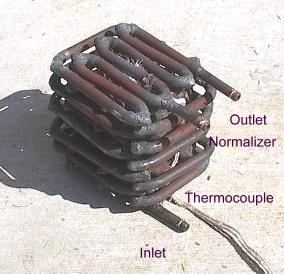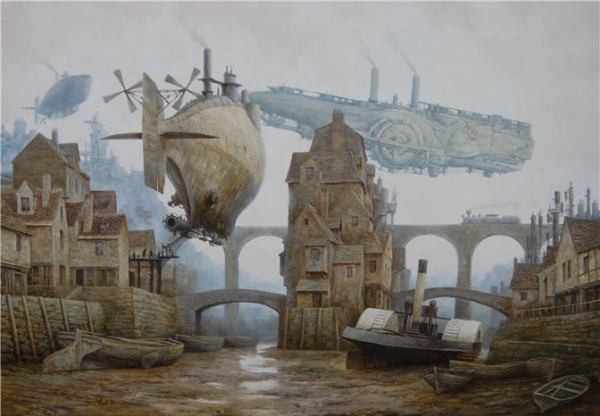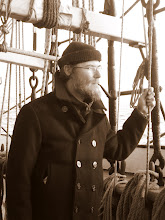More Engines, Tanks and Bulkheads Oh My!
After my last post, I was asked for more details on the high pressure steam system I described. I was also asked if I had an estimate of the power that could be developed and what the power requirements would be for our airship.
I will do the former in this post, but the latter will have to wait until I can do some calculations with my trusty Excel(tm) spreadsheet 
In my last post I described the high pressure boiler as being more or less conventional, in that a coil of high temperature oil was used to boil water in the boiler. Thinking further about this I think the reverse makes more sense. That is, a "Flash Boiler" type of system in which the steam generator coil is immersed in the high temperature oil coming from the core.
In a conventional flash boiler the steam generator is a long coil of tubing, usually made of iron or fairly thick copper. The hot gases from the firebox impinge directly on this tube, keeping it well above boiling point. Unlike a "water tube" boiler in which the tubes carry a mixture of liquid water and steam, flash boiler steam generator coils are filled with steam only. The water, which is pumped in by the feed pump, quickly evaporates and then is superheated on its way through the coil. (Superheated steam is steam that is hotter than what results from boiling so the steam carries more energy per unit volume.) Boilers of this type were common in steam cars and are still used in systems where high pressure steam is required and where the weight of the boiler needs to be minimized, which describes our requirements pretty well actually. There is a short Wikipedia article on Flash Boilers with links for further reading.
This is the flash boiler from the steam powered moped I posted about recently.
Flash boilers have several advantages and disadvantages.
The advantages are that no separate superheater is required, which reduces the weight and complexity somewhat. The rate of steam production can be easily controlled by the feed pump rate. In conventional flash boilers the heat source is combustion, so liquid fuels were often used so that the combustion rate and temperature can also be controlled. Flash boilers can handle much higher pressures and temperatures than conventional boilers. Also there is no need for a tank like section to separate the steam and water which reduces the weight even more.
There are two major disadvantages to Flash Boilers. The first is that since the tube of the steam generator is not filled with a mixture of water and steam, but only steam, it is prone to hot spots and extreme thermal stresses, which drastically shorten the service life of the boiler. The second results from the lack of reserve steam volume in the system. If there is a sudden increase in demand, say in a steam car when the throttle is opened suddenly, there is no store of water in the boiler tank ready to turn into steam when the boiler pressure is momentarily reduced. Any increase in demand must be matched by increased feed pump rates. This induces a considerable lag in the response and this lag gets worse the larger the flash boiler, as the generator coils are necessarily longer in larger boilers.
Of course in the case of a steam powered car this disadvantage is actually an advantage, if the car is in an accident there is no boiler full of liquid water above boiling point ready to flash, i.e. EXPLODE, into steam if the boiler is ruptured.
So given these fairly significant disadvantages, why did I choose a flash steam boiler for the high pressure system in our airship?
The simple answer is that those two main disadvantages do not really apply!
First, the hot spots and thermal stress.
The flash steam generator coil is immersed in a tank that contains oil at the very high temperatures of the inner core of our power source (possibly higher than 250C). This tank is essentially at constant temperature so there are no hot spots generated as there would be in the presence of the gases from combustion. The lack of thermal stress means the tubes can be thinner which improves their heat transfer capability.
Second, the lack of reserve steam volume for sudden changes in demand.
The high pressure and superheated steam from our flash boiler is being used to drive a steam turbine. This turbine runs most of the time at a pretty constant speed. If the generator that is driven by that turbine is sized appropriately it will be capable of generating the power needed for cruising flight speeds, with a small reserve for maneuvering. Controlling the feed pump rates will be sufficient to control the steam production for most normal operations.
Now in a conventional steam turbine system the exhaust from the turbine is well below atmospheric pressure. This is because of the condenser, as the steam is converted back to water its volume shrinks bringing with it a corresponding drop in pressure. This low pressure exhaust drastically improves the overall efficiency of the conventional turbine by reducing the fuel costs associated with the boiler itself. In our case the main condenser is mostly handling steam already very close to atmospheric pressure because of the excess steam from the low pressure lift steam generator. As a result there will always be some back pressure on the turbine exhaust. However the efficiency/fuel cost issue that would cause does not apply in our case, courtesy of our awesome power source. A separate conventional condenser could be added just for the power plant, but it would be heavy relative to its added efficiency value, so I have decided to eliminate that weight.
As I described last time if we need a sudden boost in power, like in an emergency, we direct the exhaust to the funnels which go directly to the atmosphere. Of course the higher we are when that happens the bigger the boost we will get.

Given that we are entirely dependent on this single boiler/turbine/generator for our propulsion, doesn't that add a significant risk of single point of failure?
Yes it does, however we must keep in mind that we are a lighter than air vehicle. Unlike a conventional aircraft which is entirely dependent on its engine to fly, if we loose propulsion power we simply stop moving. We won't crash unless we are blown into something else at our altitude. If we loose containment of the steam lift gas, via rupture or damage to the hull and lift gas bags, we are doomed anyway so having redundant power sources is simply excess weight.
That said, a detailed weight/power calculation might result in there being more than one boiler/turbine/generator needed, however until I get around to that calculation I'm going to stick with one.
Next time as promised I'll deal with the auxiliary equipment in the engine room and start to describe the more human friendly parts of our airship.
Oh and check out this fabulous painting by *Voitv for your Airship dreams.
Keep your sightglass full, your firebox trimmed and your water iced.
KJ
Check here for the next part in this series.
You can follow the full design thread by clicking on the tag "Flight Engineer".





~ 0 comments: ~
~ Post a Comment ~